
| WWT Shows | CLICK TO: Join and Support Internet Horology Club 185™ | IHC185™ Forums |

|
• Check Out Our... • • TWO Book Offer! • |
Welcome Aboard IHC185™  Internet Horology Club 185
Internet Horology Club 185  IHC185™ Discussion Site Main Page
IHC185™ Discussion Site Main Page  Interesting Horologically Based Stories
Interesting Horologically Based Stories  Larry Buchan's ..."Tales from the Rails"
Larry Buchan's ..."Tales from the Rails"  Some Railroad Trivia
Some Railroad Trivia
 Internet Horology Club 185
Internet Horology Club 185  IHC185™ Discussion Site Main Page
IHC185™ Discussion Site Main Page  Interesting Horologically Based Stories
Interesting Horologically Based Stories  Larry Buchan's ..."Tales from the Rails"
Larry Buchan's ..."Tales from the Rails"  Some Railroad Trivia
Some Railroad TriviaPage 1 2
Related Content: Pocket Watch Discussions
Go  | New Topic  | Find-Or-Search  | Notify  | Tools  | Reply to Post  |  |
| IHC Member 1668 |
Hi, I hope I'm not posting in the wrong place but I just wanted to try putting another picure on this post. This is the watch I posted yesterday. But the picture that follows is a picture of something that a railroad conductor or engineer will know all too well. Anyone care to take a guess what it is? (except you railroaders)? 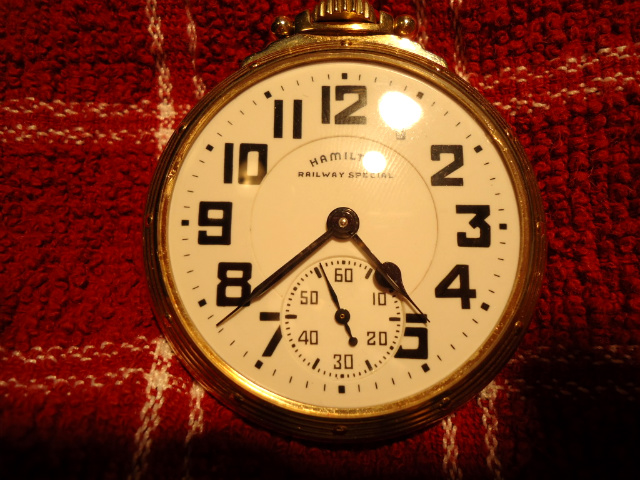 | ||
|
| IHC Member 1335 |
whatever the reason Donnie the picture is tiny,as is the item in the picture, which I blew up and still have no idea what it is!! | |||
|
| IHC Member 1668 |
Lets try again. This is better! What is it? 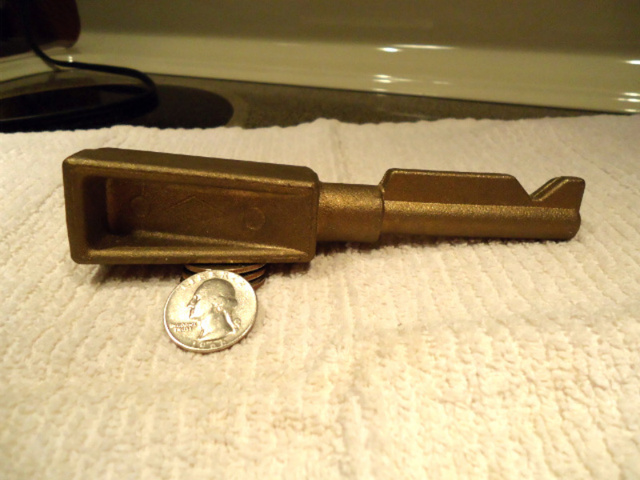 | |||
|
| IHC Life Member |
A key for a train. My guess is a diesel Electric | |||
|
| IHC Member 1541 |
Donnie, that is a gem, on CN before I retired they were all made of some sort of black plastic. | |||
|
| IHC Member 1668 |
Lorne, About 99.9% of them are still black plastic. This one came on a complete reverser replacement for a EMD SD40-2 locomotive. It came with this brass one. I have only seen a couple like this. Donnie | |||
|
| IHC Member 1541 |
Those things were hard on the hand if you worked a switcher, maybe that is the reason the newer plastic ones have a rounded handle. I was just out in the shop looking for an old cast one that was used on the older bullet nosed units. All I found was a couple the black ones. I know that thing is around here somewhere. | |||
|
| IHC Vice President Pitfalls Moderator IHC Life Member |
That's very interesting. How about a picture of one of the plastic ones for the benefit of us non-railroaders? Best Regards, Ed | |||
|
| IHC Life Member |
Reverser replacement??? Is it a door key???? | |||
|
| IHC Member 1291 |
This is a "key type" lever that fits into a slot in the control panel/module that the engineman/engineer/motorman/operator sits in front of, inside the locomotive. It inserts and pulls out and has 3 positions to control the direction of an engine and/or train manually; forward, neutral, and reverse. When centered in neutral, the key or "reverser" as it is called in the RR industry workplace, can be removed from the slot in the module or control panel/stand. When trains are left unattended, each RR line that I am aware of requires that this key looking "reverser" be centered and removed from the control panel notch it fits in, and air brakes fully applied on the locomotive consist as well as each train car being pulled behind. IN ADDITION, manual application of a sufficient number of "hand brakes" must be applied to the locomotives and cars in the train that would keep the train from moving or rolling away just in case the air brakes failed or were inadvertently released. There are recorded instances where an "air cylinder" tank or valve on one or more cars or locomotives that applies, regulates, and keeps the air brakes applied, have developed an air leak that has led to the entire air brake system becoming depleted/discharged and subsequently allowed the train to "roll" or move under it's own momentum, IF a manual application of hand brakes are/were not utilized. To operate a locomotive and or train the engineman has five main controls, the reverser, the throttle, engine brake, and the air brakes for the train cars that are being pulled behind the locomotive. The fifth control is the dynamic brake which operate and brake/retards the entire train including locomotive[s], without using air brakes for the cars being pulled behind the locomotive and the locomotive[s] itself, by "reversing the diesel engine/engines in the locomotive consist and using that retarding power to brake and control the speed of the entire train when the train is in motion. This type of braking "power" is used in many industries including but not limited to RR's, trucking, & the airlines in related applications. Dynamic braking has become the rage of the rail industry in the last 20 years universally since there are less problems, fuel savings, and less maintenance involved in using this braking system by itself or in a blend with the air brakes. Before "dynamic braking", the train was slowed or stopped by using air brakes only that operated on each and every car being pulled. And while using air brakes only, the "run-in & pull back" of the cars being pulled had to be negotiated and maintained by using the throttle [throttle modulation] fast/slow [+/- Positions 1 thru 8] to control the run in and run out of the "slack" to keep the train from breaking into one or more pieces especially on grades [terrain] since part of the train may be going uphill while part of it may be going downhill [as in hills and dales] being traversed. There were a lot of problems before dynamic braking, since each car will brake differently [+/-], and each car and locomotive has a set of brake shoes that wore down, and if one of those cars being pulled or a locomotive in the consist malfunctioned while being air braked, the brakes may not release/apply when asked to, and/or you may have an "undesired emergency"[UE], generally caused by an ABD valve failure, which would put the entire train into a severe catastrophic braking/stop mode, and would/will not reset until the train comes to a complete stop. These "reversers" are made in hard plastic composite material and they were cast in metal also. The majority are hard plastic in black, but you will find a few in red/white/and green and they are RARE. They are a universal, general purpose "key looking apparatus", a reversing handle, that works in all diesel electric locomotives and on all lines from the different locomotives and rail companies interchangeably. They do not crank, fire-up, start, or turn the engine over, they merely allow the engine/train to go directionally, forward/backward or to remain in a neutral position much like the gear shift in your personal transportation conveyance. Railroading "101" regards, bb  | |||
|
| IHC Member 1541 |
There you go Ed. Someboby was trying to sell one on ebay a few years back, I didn't follow it but not a good idea. Buster, good description. When CN went back to Dynamics in a big way they saved a whack of money on fuel and brake shoe replacement but sadly the ranks of the car department shrunk considerably. Please notice my Union Machinists Tool Chest that I paid way too much for. I am however very happy with it. Original finish and she buffed up real fine. | |||
|
| IHC Member 1668 |
VERY GOOD Buster!!! You covered that very well and answered the question correctly, it is a reverser handle.You were right as well Eugene when you said "a key for a locomotive". That is basically what it is. Thanks everyone for the great answers. Donnie T Thanks Lorne for the picture | |||
|
| IHC Life Member |
There was one at a walk in auction that sold cheep. Under $20. I guess $20. was cheep. What was it worth? As Lindel and a few people Know I find all Lot of items reasonable priced. An if one shows up again I buy it. | |||
|
| IHC Member 1291 |
While certainly not illegal to have,possess or own They are for the most part useless Unless you have a diesel electric locomotive At your disposal or in the barn Or are a collector of RR items I would say $20 would be a max value to anyone regards, bb | |||
|
| IHC Life Member |
Thank You Buster. | |||
|
| Railway Historian IHC Life Member Site Moderator |
I have a collection of them which I will show some photos later, the black plastic reverser keys, were not the only control handles that were replaced from ones made of metal, there was one other style of reverser used on earlier General Motors diesels, and also automatic brake handles, and independent brake handles were all replaced with black and sometimes red plastic. I preferred the brass model of the reverser handle for switching with, as they had a little bit of weight to them and it was easy to swat it over from reverse to forward, I was sad to see them go. On another note most locomotive engineers I worked with, including myself always carried an extra one in your grip, which I would carry in the side pocket of my overalls went on duty, the reason being sometimes you had to change ends on the locomotive consist, and after walking the distance of five locomotive lengths, only to discover there is no reverser, it sure saves a lot of walking, and sometimes you'd be called out for a work train in a remote location where your working locomotive had been set out by another freight crew, by carrying an extra reverser could save you a lot of time sitting idle waiting for someone to bring you a replacement. When locomotives were left unattended like Buster mentioned, the reverser handle was always taken out, which could be only done in the central or neutral position, if left in the forward, or reverse position they were interlocked into the control stand, I remember one situation where I have to pick up an additional locomotive from a remote station, when going out to couple on to our train, the locomotive would not load up or move forward, further examination found that someone had left the reverser in, in the forward position, and the locomotive was facing in the other direction so it would not move until it was removed. On our property when the reverser was taken out, and the locomotive left unattended it was usually hidden in an electrical cabinet, or behind the door where the number lights were located, there was also a folder on the control stand for them. Buchaneer | |||
|
| Railway Historian IHC Life Member Site Moderator |
Here are three photos of the reverser keys for the General Motors diesel locomotives, the one on the right in green his original equipment circa 1965, they also came in a reddish brown color, the brass one came out in the late 1970s, and the black plastic ones in the late 1980s. I moving this thread over to Tales from the rails category. 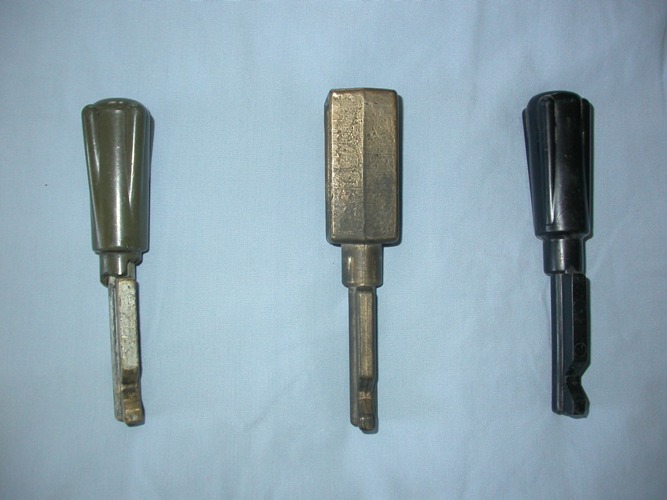 | |||
|
| IHC Life Member |
The one I seen at a auction was like the one on the left. With a green handle. | |||
|
| Railway Historian IHC Life Member Site Moderator |
Here is an earlier General Motors locomotive reverser used on the old F-9 passenger A units, and the GP-7's, the one on the Right is plastic, and the one on the right is the original nickel plated steel. 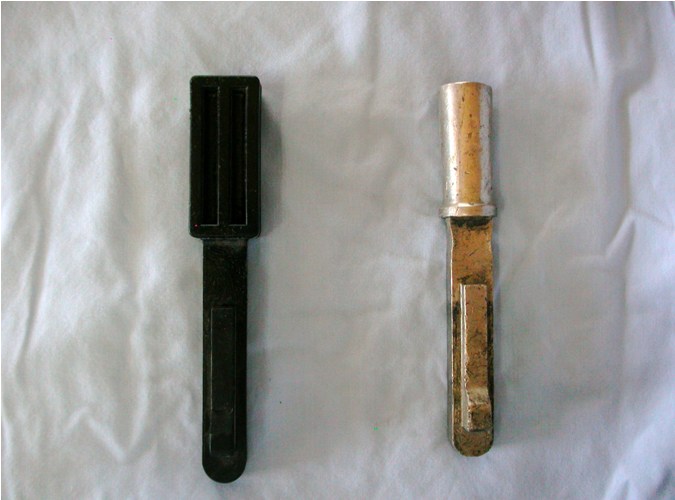 | |||
|
| Railway Historian IHC Life Member Site Moderator |
Side view.  | |||
|
| IHC Member 1668 |
Thanks Larry for the great pictures and good information! Donnie T. | |||
|
| IHC Member 1541 |
Larry, that metal one for the F-9 units is the one I was looking for out in the shop. I sure hope it didn't get tossed out. Up here in the late 70's and early 80's we used those units on freight all of the time as the track wouldn't take the bigger 5000's. The rail was too small and many curves too tight for the 6 wheel trucks. It was a god time to be a railroader, we rebuilt the whole line so it could handle heavy coal trains and the big power to pull them. | |||
|
| Railway Historian IHC Life Member Site Moderator |
Thanks Donnie for starting this topic, Lorne interesting footnote about the lighter rail, and tight curves that prohibited six wheel trucks, we had a lot of branch lines on the prairies were the six wheel trucks were prohibited, and that never changed. Here is a photo of the reverser in the reverse position on the aluminum pedestal of CPR 8635 built October 30, 1956 as a DRS-17c (Diesel Road Switcher-1700hp-e subclass) Note CPR 8635 along with 8633, and 8634 had their short hood chopped to low-nose configuration, and hump controls installed between December 1970, and May 1971. The box with pushbuttons and meter above my gloves are controls for the hump, along with cab signals in the box alongside the window. The throttle handle is on the right-hand side of the pedestal, and the lever to the left below the booster air gauge was for changing transition, and going into dynamic brake, the independent brake handle for the locomotive is in the middle, and the 24-RL automatic brake handle is visible on the left. Air gauges are visible behind the telephone handset hanging on the whistle cord, and the headlight dimmer switch to the left. 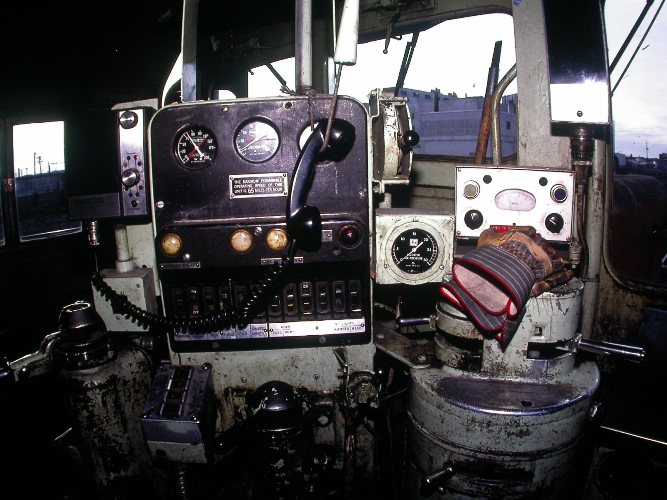 | |||
|
| Railway Historian IHC Life Member Site Moderator |
CPR 8635 and 8101 at Alyth Yard, Calgary circa 1972 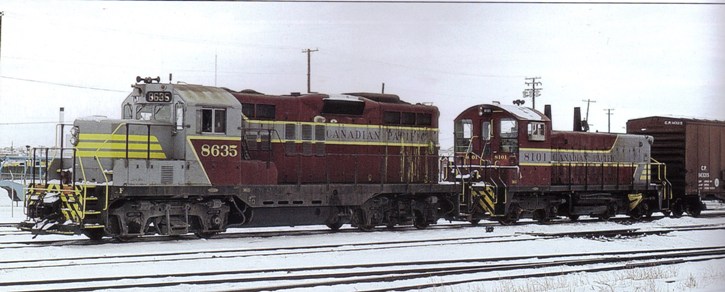 | |||
|
| Railway Historian IHC Life Member Site Moderator |
Photo of cab unit CPR 1413 with aluminum pedestal control stand, just like the CPR 8635, I took this picture in June 1980 when I was firing the CPR Canadian No. 1 Passenger train, the locomotive engineer is Mickey Cochrane, we are waiting to go West out of Calgary's passenger depot to field, British Columbia. 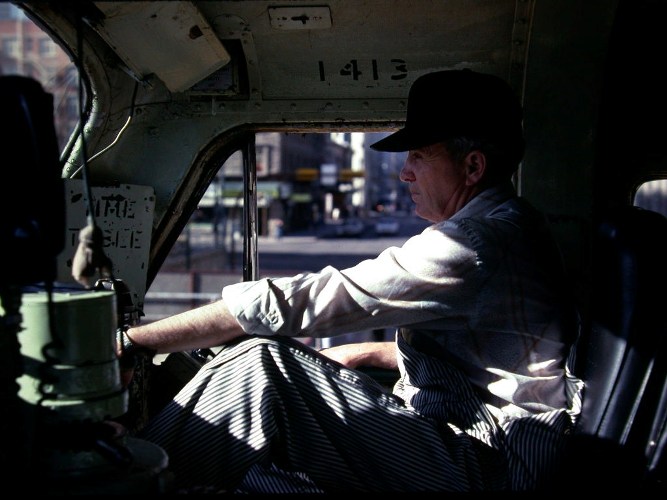 | |||
|
| Railway Historian IHC Life Member Site Moderator |
Photo of CPR 1413 in its CP Rail livery taken at Medicine Hat, Alberta December, 1979 prior to departure to Calgary, Alberta on the CPR's Canadian No. 1. It was built May 14, 1954 as a DPA-17a (Diesel Passenger A unit 1700-horsepower-a subclass) one of 12 in this subclass number 1405 to 1415 these were the first FP9A 1700 hp units that the CPR ordered from General Motors Electromotive Division for the dieselization of the railway, these units were all sold to VIA Rail (a Crown Corporation owned by the federal government) when they took over passenger service in Canada in 1978.  | |||
|
| IHC Member 1668 |
Larry would you like to go back and make one more run? Very, Very nice pictures!! Thanks for sharing them with us. Donnie T. | |||
|
| IHC Member 1541 |
Nice pics Larry, I can smell the diesel fumes in the cab. | |||
|
| IHC Member 1291 |
The "local yokels" talk about their big blocks and their Hemi's all night and all day....... But very few have rode bareback with 5,000 H.P. Between their legs Head 'Em Out Boy's regards, bb | |||
|
| Railway Historian IHC Life Member Site Moderator |
Hello Donnie, yes I would like to go back just one more time, but the memories will be good for now. Lorne yes the smell of diesel, and the high decibel level in the cab at throttle eight, and with the whistle mounted on the roof it got pretty noisy, but that was tame in comparison to walking down along the the EMD engine block, to go check the load meter, or troubleshoot any other problems in the locomotive consist. You're right Buster there is no comparison between Dodge Hemi's and the supercharged General Motors diesels. Here is a photo of the control stand on the CPR 5778 a General Motors SD-40-2 built February 27, 1978 as a DRF-30q (Diesel Road Freight-3000hp-q subclass) DRF-30r started with CPR 5779. This one has the reddish brown colored reverser labeler in the forward position, you can see the other controls Buster talked about earlier, the throttle handle above, and the dynamic brake handle above and to the left, above my timetable and track profile are the airbrake gauges, and to the right is the load meter showing amps in the green zone, and red when you're really pushing the envelope, this is where bad things can happen like pulling out a knuckle, or worse than that a drawbar on the wrong end of a car, or if you stay in it too long traction motors start to burn out. The orange zone is when you are in dynamic braking. The switches on the left our for sand, the top switch sands the front truck only, while the pushbutton switch below works the sanders on all units but must be held in all the time. 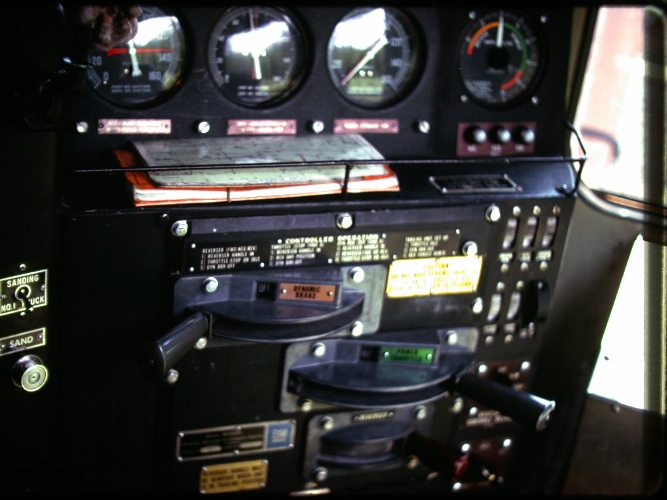 | |||
|
| Railway Historian IHC Life Member Site Moderator |
This view shows the rest of the control stand with the red handled 26L automatic brake for the whole train it is in the release position, my train orders are behind the handle, below that is the independent brake handle that applies and releases the brakes on the locomotives, it is in the full application position, the frequency radio control is to the left, with the ditch lights switch below, and the panel below that has the rear headlight control, a power reduction switch that knocks the lead axles from throttle eight to throttle seven when needed, the little white red and orange rectangles are alarm lights that will bring your attention to conditions like a slipped pinion on a traction motor in red, pneumatic control light in white when the train is in emergency, the brass handled button below the sander switches operates the locomotive bell when pulled out. There is also a no-no in this photo, can any of you spot it out? 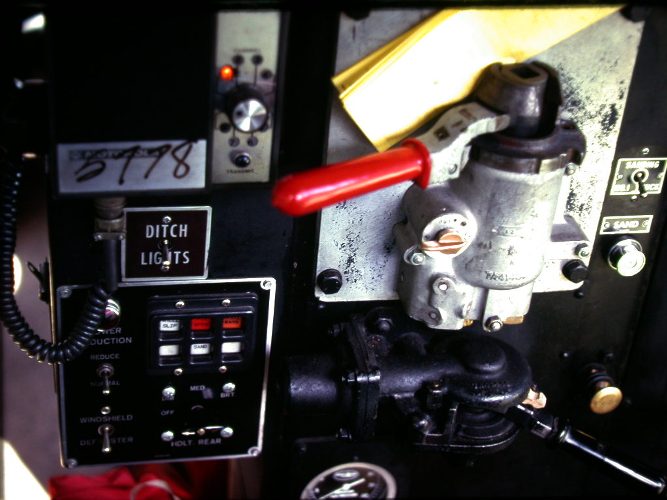 | |||
|
| IHC Member 1541 |
Ha Ha, I won't say anything for now but that was a factor the first time I put an engine on the ground. We split a yard switch and I dumped the air right away but kept going for quite a ways. In the statement I was asked,"If you weren't speeding why did you travel so far after you went on the ground". I just said it was my first derailment and I was a little late reacting. They bought it! Nowadays they would just download that time period and send you some Brownie points in the mail. | |||
|
| IHC Member 1291 |
Keeps those engine brakes bailed off regards, bb | |||
|
| Powered by Social Strata | Page 1 2 |
| Your request is being processed... |
|
©2002-2025 Internet Horology Club 185™ - Lindell V. Riddle President - All Rights Reserved Worldwide

